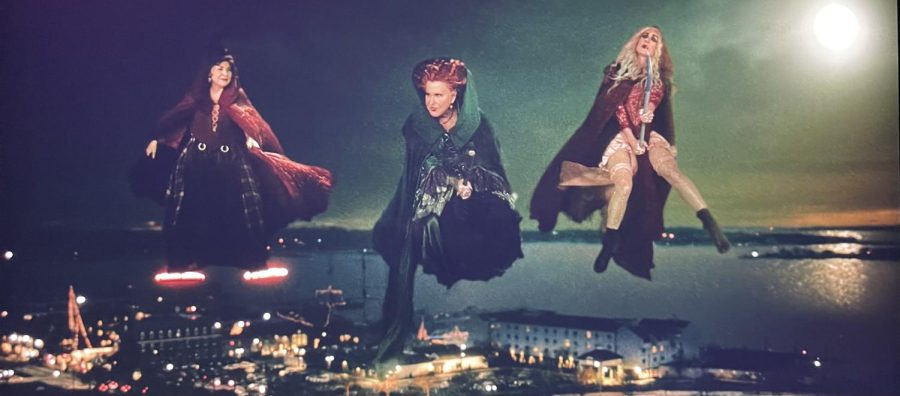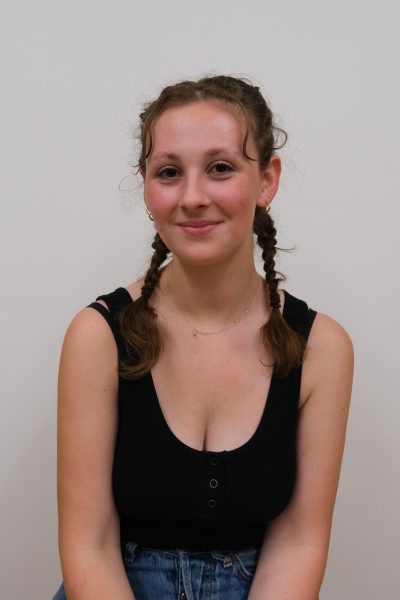Hocus Pocus: A Deeper Look into Societal Beauty Standards
October 30, 2022
Nineteen years after the Halloween staple fall family film, Hocus Pocus, came out, a sequel was released. Hocus Pocus 2 came to the streaming platform Disney+ on September 30, 2022. Incorporating the original Sanderson sisters: Winifred (Bette Midler), Sarah (Sarah Jessica Parker), and Mary (Kathy Najimy), Hocus Pocus 2 brings us through another All Hallows Eve full moon night where the sisters are accidentally resummuned. This time into the 21st century, where modern advancements throw these medieval witches into a whole new world.
At the beginning of the film, we are taken back to Salem, Massachusetts 1653, where we see Winifred’s 16th birthday. We see the sisters being outlawed from their town, called ugly and deemed witches. After being exiled by society, the Sanderson sisters find it only fitting to seek revenge on Salem, with their ultimate goal to stay young and beautiful and curse the town for centuries to come.
We then flash forward to modern day Salem, Massachusetts where the story follows three high school friends: Becca (Whitney Peak), Izzy (Belissa Escobedo), and Cassie (Lilia Buckingham), who have also been ostracized by their community; and called witches. After accidentally resummoning the Sanderson sisters, they must ban together to once again get rid of the witches before they cause harm to the town of Salem, again.
This Halloween film has shown us the classic struggle of the outsiders seeking revenge, but as you look closer at what this story is about, it’s about regaining the respect of society by staying young and beautiful. Glorifying modern societal beauty standards is common in media, but in the Hocus Pocus movies it is especially prevalent.
The Sanderson sisters’ inevitable goal is to consume the souls of children to keep themselves young and “beautiful.” Society has put the pressure, particularly on women, to stay looking young in order to preserve their beauty. As humans, aging is a natural process and part of life that shouldn’t be stigmatized as something unflattering or bad.
When the media encourages people to preserve their young appearance by all means necessary, it creates an unhealthy relationship with aging and body image. Because of this, people go to extremes to achieve this unnatural look to appeal to society.
Although the Hocus Pocus movies are not the only examples of media that encourages unhealthy beauty standards, it is one that resonates because it’s a family movie, meaning that children watch and consume these messages regarding the connection between appearance and their place in society. We see in these films that the Sanderson sisters will stop at nothing to stay immortal, young, and therefore beautiful — not even death will stop them. Is this the message we should be sending our children?
No, it’s not.
We should be teaching them that beauty is unlimited, and encourage them to disregard beauty standards and to question the long-standing stigmas surrounding power dynamics created by these standards.
As soon as kids steps outside the comfort of their home and into the “real world”, they are labeled: weird or normal, smart or stupid, pretty or ugly. These labels that are placed on us are hard to seperate yourself from. And by putting emphasis on these unnecessary and harmful labels, we are encouraging the perpetuation and use of these stereotypes.
In the first movie, the young Sanderson sisters are banished from their town and labeled as ugly, witches, weird and evil. These labels can shape a person’s character — this was certainly the case for the sisters.
Societal beauty standards lead to many harmful outcomes and young adults having an unhealthy relationship with the way they look and the way others see them.
There is already enough pressure to look young and beautiful, and when movies promote this impossible standard even more, it makes it extremely difficult for people to feel secure with both their appearance and identity.
A lot has changed since the original Hocus Pocus came to theaters in 1993, and even more has changed since 1653, when the Sanderson sisters first became witches. As society has evolved, so has our beauty standards and social trends, and we should continue to challenge these unhealthy stigmas and messages as they continue to impact younger generations.



